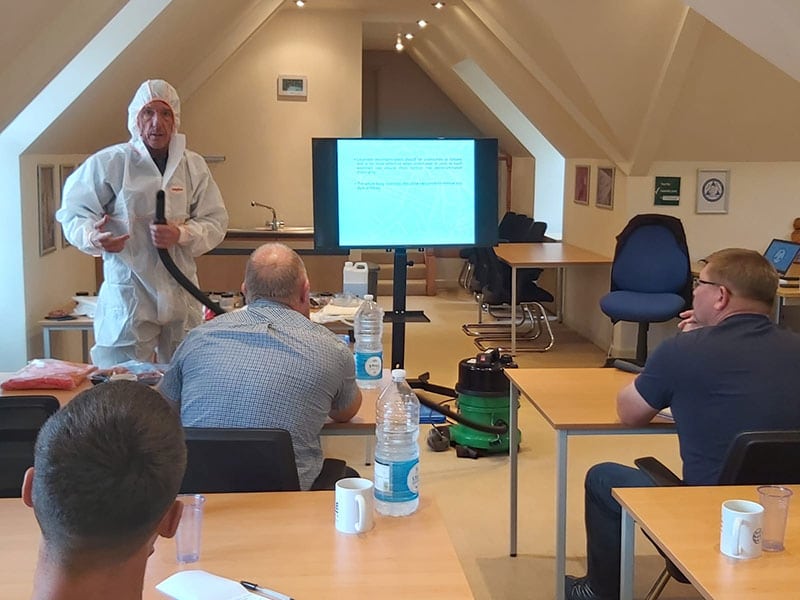Can I do an asbestos awareness course online?
Asbestos exposure is responsible for a number of hard-to-treat, life-threatening health conditions, including mesothelioma, lung cancer, and pleural disease. While it’s no longer in use in the UK, it wasn’t banned until 1999. That means that any buildings constructed before 2000 are still likely to have asbestos-containing materials (ACMs) in them.
Knowing where ACMs may be and how to maintain them so they don’t pose a risk is imperative to keeping yourself and anyone else in the building safe. Anyone who may be working with or around asbestos should have, at minimum, asbestos awareness training.
Beyond that, people in professions with a high risk of asbestos exposure — such as commercial property owners, construction workers, and landlords — should build upon awareness training with additional instruction.
How important is asbestos training?
Asbestos training can prevent exposure to dangerous, undetectable asbestos fibres. When those fibres are inhaled or swallowed, they can adhere to the lungs. They’re impossible to remove at that point, and they can lead to serious diseases several years in the future, such as:
- Asbestosis
- Gastrointestinal cancer
- Lung cancer
- Mesothelioma
- Pleural disease
The duty holder of a commercial building is the person responsible for the maintenance and repair of that property. That includes being responsible for asbestos, starting with finding where ACMs are located. From there, the duty holder will determine the risks posed by the ACMs and how to keep them safe from disturbance. Or, if they’re already in a damaged state, the duty holder will need to make a plan for removing the ACMs safely.
Asbestos awareness training is the first step to understanding the basics of asbestos. This gives the duty holder base-level knowledge that they can use to keep people on the premises safe. Also, anyone with the potential to disturb ACMs, like workers in the building, should receive asbestos awareness training to prevent exposure incidents.
Who needs asbestos awareness training?
Anyone who will be working with or around asbestos should receive awareness training. However, it’s even more crucial for those in the construction industry to receive property training. Construction-related roles that require asbestos awareness training (as well as additional training, in many cases) include:
- Architects
- Building surveyors
- Burglar and fire alarm installers
- Computer and data installers
- Decorators
- Demolition workers
- Electricians
- Gas fitters
- Heating and ventilation engineers
- Joiners
- Maintenance workers
- Painters
- Plasterers
- Plumbers
- Roofers
- Telecommunication engineers
There are many situations that require asbestos awareness training. Here are a few examples:
- A demolition crew has to destroy part of a building, but there are ACMs in the walls and roofing. Knowing the common areas where asbestos is present prevents the workers from breaking ACMs and releasing fibres into the air.
- An HVAC worker performing maintenance on a heating system knows that asbestos was often used in the insulation around ducts and pipes. They wear the proper protective equipment when on the job and avoid damaging the ACMs.
- The duty holder knows that there is asbestos in the paint used in a school classroom. They let the teacher know to not drill into the walls when decorating the room at the beginning of the year because that action would send asbestos dust airborne.
The owner of a non-domestic premise, like the property owner or landlord, also has a duty to manage asbestos. According to the Health and Safety Executive (HSE), the duty holder is responsible for protecting others on the premises, including “from the risks to ill health that exposure to asbestos causes.”
Which asbestos awareness training is best? Online vs. in-person?
Asbestos training is available both online and in person. Online, the information may be presented in pre-recorded virtual modules or via live online training. With in-person training, you’ll be in a classroom setting with an instructor who’s also there in person.
There are pros and cons to each type of training. Let’s go over them.
Online training pros and cons
Some of the benefits of online asbestos awareness training include:
- More accessibility: For many people, online training is much more accessible than attending an in-person class. Unless you’re able to go to a training course during the workday and at your place of work, online instruction is more convenient for anyone with an internet connection.
- Go at your own pace: Pre-recorded asbestos awareness training modules allow for flexible learning. They can be taken at any time and anywhere, and students can progress at their own pace. Note that some programs have to be taken within a certain amount of time from when you sign up, like 30 days, for example.
- Consistent learning: Online training provides a more consistent curriculum because everyone at a company or on a team of workers will take the same course. If different in-person classes are taught, you can’t be sure that every student will learn the same information.
- Lower cost: When you consider travel costs, online courses can be more cost-effective. You may also find that online courses cost less than live courses because they’re easier for the instructor to provide.
Some of the downsides of online asbestos awareness training include:
- Self-motivation is required: Those who do well with online courses are self-motivated. But for those who struggle with this, they may never attend the course, or they may feel like it’s a huge challenge just to get started. Putting off asbestos training is unsafe for anyone who works around ACMs.
- Limited engagement: For people who learn better when there’s a lot of engagement and interaction with the instructor, this will be missing in online training. And if the courses are pre-recorded, there won’t be any interaction at all.
- Difficulty having questions answered: If the online trainer isn’t conducting the class live, you won’t be able to ask your questions. Even if they’re available for questions, though, it can be difficult to get your query noticed if you’re competing with many other students in a chat.
- Technical issues: Online courses come with the risk of having a technical issue at any point during the class. This can disrupt the learning process temporarily or indefinitely.
In-person training pros and cons
Some of the benefits of in-person asbestos awareness training include:
- Plenty of interaction: An in-person asbestos awareness training course allows for engagement and interaction with the instructor, as well as other students. Being able to discuss issues one another has had with asbestos and ask specific questions about your industry can make the course more valuable to attendees.
- Hands-on instruction: Some aspects of asbestos awareness training are easier to learn when you can be hands-on. For example, learning how to wear and use personal protective equipment and respiratory protective equipment is more effective when you can actually do a trial run.
- Questions are answered ASAP: In a live class, students can ask questions as they arise and get clarification right away before the instructor moves on to the next point. This can make learning more effective. Students won’t have to sit through a chunk of class that isn’t making sense to them.
Some of the downsides of in-person asbestos awareness training include:
- Less availability of classes: By nature, there are fewer in-person classes than online classes. Limited options can make it difficult for the student to find a day and time that works with their schedule.
- Travel challenges: Depending on where the training course is held, some people may have difficulty getting there because of cost or transportation issues. Also, the class could be far away, which could result in scheduling issues for parents.
- Live classes are more time-consuming: In-person training may take more time than a student has to commit to the class. Whereas online training can be taken in smaller doses until the course is complete, in-person classes have longer blocks. Plus, travel time has to be added to the overall duration of the class.
- Higher costs: In-person asbestos awareness training may cost more, especially once instructor fees, printed materials, and venue costs are factored in.
Taking an asbestos awareness course online
There is no specific legal requirement to take asbestos awareness. However, the HSE does require duty holders and workers impacted by asbestos to have base-level knowledge of how to stay safe. Typically, that requires asbestos awareness training, which is why it’s become an industry standard.
There are asbestos awareness training courses offered for first-time students as well as people who have taken the training in the past and need a refresher. Courses take around three hours to complete, but they may be shorter or longer depending on the specific course and how much personal guidance is needed.
It’s a good practice to take asbestos awareness training every 12 months. However, some workers will need more frequent training. For example, a first-time duty holder may take the initial training. Then, six months later, they may find new ACMs that need to be dealt with. If they’ve forgotten some of their training, a refresher course is the safest way to move forward.
If you’re interested in taking an online training course to get up to speed with asbestos awareness, our up-to-date cost guide may help you plan. Find it here.

Written by Brendan Coleman
Brendan Coleman, with decades of experience in the asbestos industry, is a dedicated Quality Manager. Certified as a surveyor and analyst, he is adept in operations and quality management with a keen focus on HSE compliance. His expertise is pivotal in maintaining high safety and efficiency standards. Brendan ensures our UKAS accreditation requirements are consistently met and exceeded, upholding stringent standards in asbestos remediation. His commitment to enhancing quality and customer satisfaction makes him an essential advisor in asbestos management.

